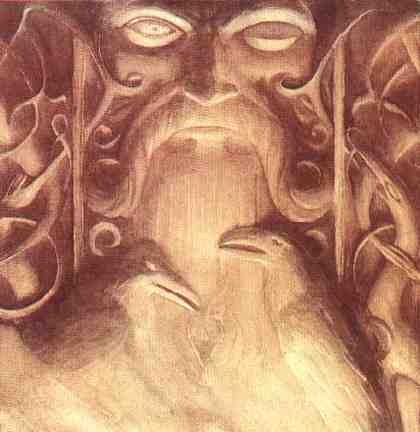
Odin, the chief Norse/Germanic god, with his ravens
“Then God said, “Let Us make man in Our image, after Our likeness.’ . . . So God created man in His own image, in the image of God He created him; male and female He created them.” – Genesis 1:26-27
Since man’s fall he has been in rebellion against God. One of the most notable forms this rebellion takes is that, instead of acknowledging that we are the creatures, that God is the creator, and that we are made in His image, we seek to turn this creation order on its head, becoming the creator and creating gods in our own image. In our sinful state, we cannot hope to measure up to a holy God’s standards, so instead we make gods whose standards we can meet and whose approval we are capable of earning. This is the case both at the individual and at the ethnic level, and it is rightly condemned by the second commandment.
There is a seldom-mentioned aspect to this which I wish to discuss in light of David’s recent article on the redeeming of aspects of our pagan heritage instead of rejecting the entirety as out-and-out evil.
We create idols “in our own image”; consequently, when we look at the pre-Christian religions of Europe, we are looking at the collective image of our ethnic and racial soul created and molded over centuries and millennia into our own image in all its beauty and all its ugliness. This image is marred by sin and is powerless to save us – only Christianity can do that – but that does not mean this image is useless to the modern-day European Christian. In this image, we see our own particular collective proclivities towards good and evil, our weaknesses and strengths, paths to emulate and paths to shun, and more. Not only do the old myths enrich our heritage, but when we sing the old songs and tell the old stories, our ancestors live again through us and can pass on their wisdom to the next generation. This is so extremely important today when all the mainstream powers are seeking to cut us off from our past and are creating a truly rootless and heritageless generation of Europeans. What better way is there to ignite the pride and imagination of young Europeans and root them solidly in the flow of their people than with tales of Odin’s quest and sacrifices to obtain wisdom, of Tyr thrusting his hand into the great wolf Fenrir’s mouth to make good a pact, of Thor’s epic battle with the giant sea snake Jormungand, or of the gods’ great last stand and battle against evil in Ragnarok at the end of the world? Surely these are better and more healthy than anything Hollywood is putting out for children, and they can easily be told as honoring our ancestors and as part of our heritage, divorced from a their original religious context, and discussed for what lessons can be taken from them within a Christian worldview. And that is merely from the Norse/Germanic mythology; add to those tales the myths of the Celts, Greco-Romans, and Slavs, and you may begin to see the great treasure trove of European heritage which a mindset of redeeming these myths for our own use and edification gives to the modern-day European Christian.
| Tweet |
|
|
|




